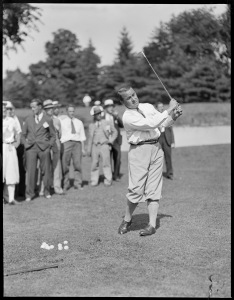Second in the series on my current set, this time the wedges.
My current pitching wedge is the one (surprise) from my set of irons, the Mizuno MP-37s. This lovely little shovel has 47 degrees loft, and you already know the other specs for the set. Nothing too surprising or revelatory here, but I will note that 47 degrees is, historically speaking, relatively strong for a pitching wedge. Having come from an old set of Hogan irons, where the Equalizer (a somewhat — sorry, Ben — cheesy appellation they put on their pitching wedge) had 50 degrees of loft, so this newer one is actually practically a 9-iron [sigh].
For too many years recently, I played with just two wedges in my bag, a pitching wedge and a sand wedge, usually a 56 degree. More recently I must have sobered up enough at some point to realize this left me with an enormous yawning gap between these two clubs (in this case 9 degrees), and this created a double No Man’s Land: one between those two clubs and one under a full normal sand wedge. Hence the “gap” wedge to fill in the former. Curiously, in my earlier days I DID carry a 55-degree Wilson Staff wedge along with a 60-degree sand wedge, so my set made sense: 50-55-60. Not sure why that ever changed as much as it did. I blame parenthood. Moving on.
To fill this pivotal gap, I chose the Snake Eyes 52 degree (same specs as other irons).
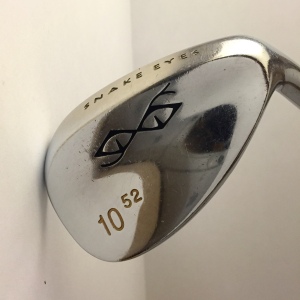
Now, this is the Original Snake Eyes, the amazingly solid wedge the company was founded on. As you can clearly tell from the phenomenal photograph, it has a reasonably narrow sole, not a lot of bounce, and is in general a functional example of modern art and purity. While my current one is getting a little smooth in the grooves, I haven’t replaced it yet or purchased a backup from eBay. My pathetically spartan playing schedule should keep this in my bag another decade or so at my present pace.
Next, the sand wedge, that most versatile of clubs. Thank you, Mr. Sarazen, you wacky plus-fours-wearing genius/magician, may you rest in peace.
For this probably-most-used of the iron weaponry, I have gone through a significant trial-by-error/experimentation/”science” process over the years. My favorites were the original Cobra Phil Rodgers ones (dating myself here). I think I wore out the grooves on three of those in high school and college, one chrome and two Rusty’s. What a glorious weapon it was: sharp leading edge, just the right amount of bounce. Sigh. Of course, the fact that I used to hit 100 sand shots a day, plus hours of weekly short game practice (some involving wagering with other course rat friends of mine) had nothing to do with my being completely besotted with this club, or anything to do with why the bottom three grooves were gone. Nope. Nothing at all.
From the marvelous Mr. Rodger’s design, I was adrift for many years. I spent quite a few years in a stable relationship with a Cleveland 56 (the 588, I believe, I’ll have to look in the storage bag). Things were good, great at times, but never amazing. More Clevelands, something in BeCu (MacGregor?), a few others I can’t remember, a lot of time playing with different shafts and grips and even grinding (read: ruining) one or more along the way until my gear-head pal in Michigan (Hi Slight Draw!) told me about Snake Eyes wedges, and I bought a handful of those. Up until recently, I carried the 52 and either a 56 or a 60-degree.
The current love of my life is a Vokey Wedgeworks TVD-M 56 (same length/shaft/grip specs as other irons).
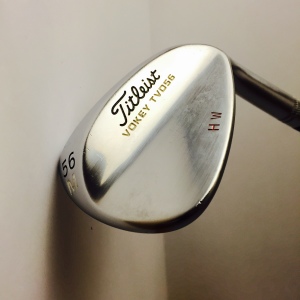
It is simply the best all-around wedge I have ever played, great from pretty much any kind of lie: soft, hard, long grass, short grass, open faced, flop, flip, punch, chip, you name it. Some sort of wizardry in the sole design, I don’t know what it is, but it never ceases to amaze me how solid and versatile this club is. The grooves, after many years of use, are STILL so sharp my ball look like it needs a haircut after. When my 52 is ready for retirement, this little guy is gonna get a companion.
Final note on wedges. While I will cover this in a future post on custom fitting, in my experience having the same shaft in ALL your irons is worth every penny. That means either custom-ordering your sand/gap wedges with the right shaft in them or taking them somewhere and having the shaft replaced to match (or you could, of course, do it yourself. It’s not that difficult.) What you do not want to do (or go ahead, I’m not your Mom) is grab a new wedge out of Bob’s Barrel O’Wedges and just think it will work fine with whatever shaft happens to be in there (unless, of course, it coincidentally already IS the same shaft as the rest of your set, duh). Every iron in my set has the same shaft and grip, and I feel like it has changed my game significantly, especially with the wedges and on partial shots.
Finally, the putter. My current putter is a Never Compromise (the black/gray/black) GM2, the one that looks like a Ping Anser. Easily the most “technological” putter I own (and one of two not-inexpensive ones.)
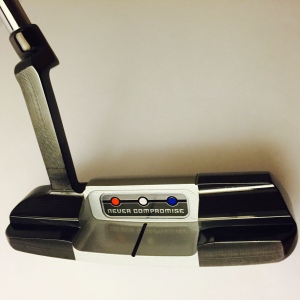 Because I am a golfing nomad and play at so many different courses, I have the one with the adjustable weights. Extremely helpful.
Because I am a golfing nomad and play at so many different courses, I have the one with the adjustable weights. Extremely helpful.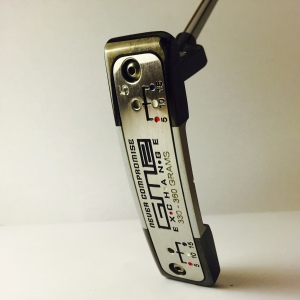
I go to the practice green before the round and assess the speed of the greens and then adjust the weight of the putter if necessary: more weight for slower greens, less for faster. This model is adjustable from 330 to 360 grams. I find it makes a surprisingly big difference. No adjusting once on the course, of course.
Never Compromise, like far too many of the manufacturers whose gear I respect, has gone through multiple owners, each gradually less interested in anything other than churning out as many sticks as quickly as they can for as much money as they can, has now landed in the Srixon family (along with Cleveland Golf. Sigh.) and makes some of the least aesthetically-pleasing putting creations I have yet seen. The “Dinero Series”? Really? (Sorry. I did promise to be positive on here.)
There are about a dozen putters in my storage bag, mostly older non-milled, non-grooved, wing-free, under $250 type stuff. I have one Scotty Cameron (Newport Beach, Studio Stainless) I got for a present which, like the original Ping Anser (brass), is so light its awesomeness is only really appreciated on super-fast greens. There are several Pings: Anser, Anser 2 (stainless), B60, and a Pal. An Acushnet Bullseye Pro, Wilson 8813 & 8802, and the trusty Zebra mallet in the original gray with white stripes (and the little black & white sock cover). All these older models are simple, are amazing putters, and have been through the rotation at one time or another for extended duty. A few have been ground (and are now dandy canes), some have been reshafted (crazy difficult with a Ping), most have been regripped or at least covered with multiple layers of white athletic tape ala Scott Verplank. (I thought that was genius, back in the day. Grip slippery? Peel off a layer. Or, hey, add another one. Boom. Done.)
Exit Poll: Why can’t I still buy the classic Anser 2 in stainless steel without grooves or colors or other sorts of tomfoolery? WHY PING? WHY? That was an amazing putter, just ask Greg Norman. Why does every putter today have to be “milled” of some insane alloy developed by a joint venture between NASA, Boeing, the Ukrainian Technical Institute, and a hobbyist engineer named Irving from Pasadena? Or be some unnatural color(s) or shaped like a bizarre spaceship or prehistoric insect? Or, if it’s NOT a combination of those things, it still MUST cost a minimum of $200, and preferably $350. WHY? Rhetorical question, children. Because people who have too much money are willing to spend $350 on a putter. And there are apparently a LOT of these people. I am not one of them. Perhaps you’re one of them. It’s a semi-free country, go right ahead. Free market, I get it. But does that mean these creations have to be the ONLY choice I have? Can’t Ping dash off a few of the classics each year? Please?
Next up in this series: Marmaduke and The Truant. (The next post chronologically will more likely venture off into the rough on a different topic, though.)
